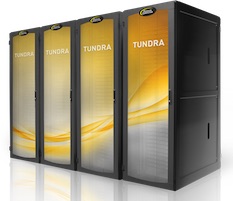 Penguin Computing, a provider of high performance, enterprise data center and cloud solutions, announced its transition from pre-production deployments last year of systems based on the Intel Xeon Phi processor to full production for Penguin’s Tundra product family.
Penguin Computing, a provider of high performance, enterprise data center and cloud solutions, announced its transition from pre-production deployments last year of systems based on the Intel Xeon Phi processor to full production for Penguin’s Tundra product family.
We received early access to the Intel Xeon Phi processor through Penguin Computing and its OCP-based Tundra Extreme Scale (ES) Series,” said James Laros, Principal Member of Technical Staff, Sandia National Laboratories. “We are seeing very promising results to date.”
Penguin Computing’s Tundra Extreme Scale Series provides the market with density, serviceability, reliability and optimized total cost of ownership for highly-demanding computing requirements. In addition to adoption in the federal market, the OCP-based Tundra cluster platform is highly-effective in a range of commercial industries such as financial services, higher-education, scientific research and manufacturing. Now in full production, the Xeon Phi processor combined with Penguin Computing’s new Relion Phi X1030 server can provide extreme compute densities of up to 81 processors in a single 40 OU cabinet.
“Our customers appreciate the scalability and interoperability of the Tundra platform and their purchasing decisions are reinforcing the rapidly growing credibility of the Open Computing model,” said Tom Coull, President and CEO, Penguin Computing. “Support for the production Xeon Phi in Tundra ES now provides organizations and developers with the power and scalability of Intel’s Many Integrated Core Architecture in an Open Compute platform.”
The Intel Xeon Phi processor supports discovery and business innovation in science, visualization and analytics. It helps organizations solve the biggest challenges faster via scalability, eliminating bottlenecks and highly-parallel computing. The Intel® Xeon Phi processor also provides unmatched value through power efficiency, programmability and high utilization. It maximizes future potential with future-ready code, a broad ecosystem and robust roadmap.



